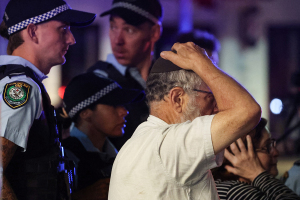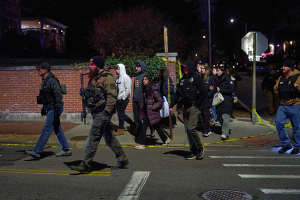In Pennsylvania, forgotten forts and George Washington

Tucked away in southwestern Pennsylvania are two forts from an almost entirely forgotten war.
About 90 minutes by car from Pittsburgh and near the Pennsylvania border with West Virginia and Maryland in the picturesque Laurel Highlands are the reconstructed earthworks and makeshift circular palisade at Fort Necessity National Battlefield.
This was where the first battle in the French and Indian War, as the North American theater of the Seven Years’ War is called, occurred. The war’s official name is actually a misnomer. Not only did armed conflict last longer than seven years — 1754 to 1763 — but the first world war as most of Europe was entangled on one side or the other in military engagements spanning five continents.
The battle at Fort Necessity on July 3, 1754, ended in disaster for 22-year-old George Washington, who as a lieutenant colonel in the royal colony of Virginia’s armed forces commanded just under 400 British regulars and colonials. This was actually the first of two consecutive disasters for Washington — disasters that derailed his long sought-after military career until the cause of American independence some 21 years later.
Fort Necessity itself was a reaction to a skirmish that occurred about six weeks earlier at what is today called Jumonville Glen.
It was here where Washington’s colonials and Indian allies surprised the French, who were camped below a rocky cliff in a naturally indefensible location. Just what transpired next remains debatable today, although the death of the commanding French officer, Joseph Coulon de Villiers de Jumonville, was considered an assassination by France.
Word of the skirmish made it back to the French at their stronghold of Fort Duquesne (pronounced doo-kayn) in present-day Pittsburgh. Soon, de Jumonville’s half-brother led a force against Washington. While the skirmish was not enough to cause a world war, the later battle in a no man’s land claimed by both France and Great Britain was more than enough to revive centuries-old hostilities.

Fort Necessity was hopeless from the start.
Washington never cleared the tree line surrounding what was called the Great Meadows. This gave a considerable advantage to the French, who shed conventional tactics for the guerilla warfare of their Indian allies. Combined with bad weather, a lack of useable supplies and mounting casualties, Washington surrendered for the first and only time in his career.
Washington’s second disaster, which admittedly was actually that of commanding officer Maj. Gen. Edward Braddock, came about a year later. This time, he was merely an aide.
The 60-year-old Braddock marched more than 2,000 soldiers on a 12-foot-wide road his troops blazed through forests and over mountains toward Fort Duquesne. The expedition turned into a disaster on July 9, 1755, when the outnumbered French and Indians surprised the British and Americans after they crossed the Monongahela River some 10 miles from the fort.

With around 900 casualties among approximately 1,400 regulars, the battle was one of the worst-ever defeats for the British Army. The major general himself was shot and later died during the retreat. After reading the burial service from the Church of England’s 1662 Book of Common Prayer, Washington had Braddock buried in the middle of his road to avoid the body’s discovering and desecration by Indians. Today, a monument stands at this location, about a mile from the Necessity battlefield at the Great Meadows.
Britain’s war effort improved by 1758, when a new army under Brig. Gen. John Forbes moved west from Philadelphia toward Duquesne.
His force, which numbered more than 6,000 and included Washington in command of a Virginia-raised regiment, was so overwhelming that the beleaguered French destroyed their fortress the day before a brigade led by Washington arrived on Nov. 25, 1758.
Parts of their route, called the Forbes Road, included the earlier Braddock Road. Along the way, they erected several temporary forts that were basically the equivalent of truck stops and rest areas. One such fort was Fort Ligonier, which was named after the field marshal of the British Army.

A full reconstruction stands at the original location in Ligonier, a charming small town in Westmoreland County. Besides the reconstructed fort there is the museum’s spectacular collection of objects and artifacts, including original art from the era — the kind of art generally only found in a big-city museum. This is without a doubt the best museum dedicated to the French & Indian War anywhere.
While the fort’s actual role in the war was minor compared to Jumonville Glen or Fort Necessity, it is the best place to discover this important chapter of American history.
If you go
Admission to the National Park Service-operated Fort Necessity National Battlefield, including the visitor center and museum, is free. This includes Jumonville Glen.
Tickets for Fort Ligonier range from $8 for children to $15 for adults. Consider booking a private sunset tour for $35 per person. Fort Ligonier Days, an annual reenactment, takes place Oct. 8-10.
I stayed at the Fairfield Inn & Suites by Marriott in Somerset, one of the closest towns of any significant size. It was a perfectly fine chain hotel. However, I wish I had stayed at either the Historic Summit Inn, near Fort Necessity, or in Ligonier at Thistledown.
Getting here by car is especially easy as Pennsylvania’s Laurel Highlands is within driving distance for many Americans. If you wanted to fly, the Pittsburgh airport is the closest airport with significant service from commercial airlines.
Follow @dennislennox on Instagram and Twitter.
Dennis Lennox writes about travel, politics and religious affairs. He has been published in the Financial Times, Independent, The Detroit News, Toronto Sun and other publications. Follow @dennislennox on Twitter.



























